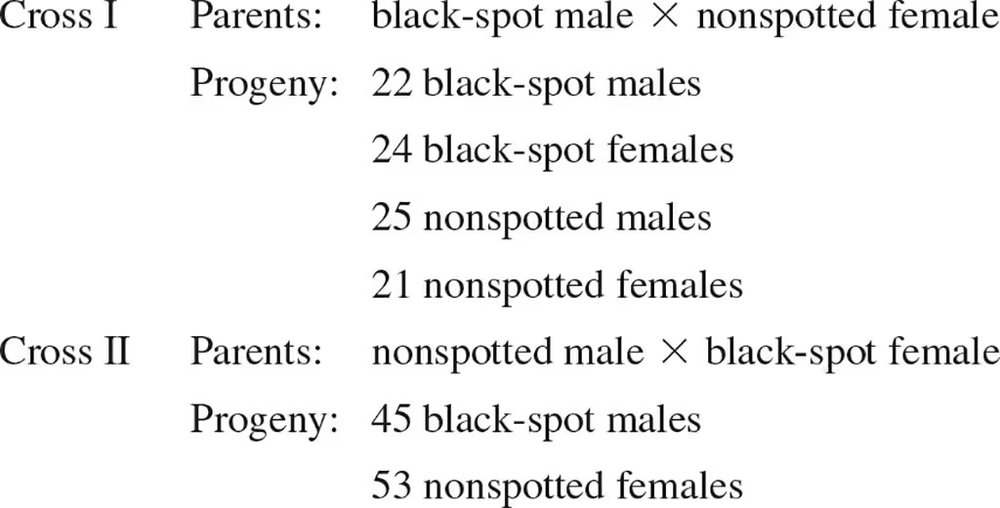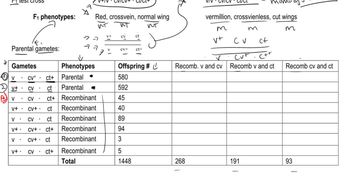The genes encoding the red- and green-color-detecting proteins of the human eye are located next to one another on the X chromosome and probably evolved from a common ancestral pigment gene. The two proteins demonstrate 76 percent homology in their amino acid sequences. A normal-visioned woman (with both genes present on each of her two X chromosomes) has a red-color-blind son who was shown to have one copy of the green-detecting gene and no copies of the red-detecting gene. Devise an explanation for these observations at the chromosomal level (involving meiosis).
Table of contents
- 1. Introduction to Genetics51m
- 2. Mendel's Laws of Inheritance3h 37m
- 3. Extensions to Mendelian Inheritance2h 41m
- 4. Genetic Mapping and Linkage2h 28m
- 5. Genetics of Bacteria and Viruses1h 21m
- 6. Chromosomal Variation1h 48m
- 7. DNA and Chromosome Structure56m
- 8. DNA Replication1h 10m
- 9. Mitosis and Meiosis1h 34m
- 10. Transcription1h 0m
- 11. Translation58m
- 12. Gene Regulation in Prokaryotes1h 19m
- 13. Gene Regulation in Eukaryotes44m
- 14. Genetic Control of Development44m
- 15. Genomes and Genomics1h 50m
- 16. Transposable Elements47m
- 17. Mutation, Repair, and Recombination1h 6m
- 18. Molecular Genetic Tools19m
- 19. Cancer Genetics29m
- 20. Quantitative Genetics1h 26m
- 21. Population Genetics50m
- 22. Evolutionary Genetics29m
2. Mendel's Laws of Inheritance
Sex-Linked Genes
Problem 24b
Textbook Question
In a species of fish, a black spot on the dorsal fin is observed in males and females. A fish breeder carries out a pair of reciprocal crosses and observes the following results.

Identify which sex is heterogametic. Give genotypes for the parents in each cross, and explain the progeny proportions in each cross.
 Verified step by step guidance
Verified step by step guidance1
Step 1: Understand the concept of heterogametic sex. In species with sexual reproduction, the heterogametic sex produces two different types of gametes with respect to the sex chromosomes (e.g., XY in males for humans, ZW in females for birds). The homogametic sex produces identical gametes (e.g., XX in females for humans, ZZ in males for birds). Analyze the data to determine which sex is heterogametic in this fish species.
Step 2: Analyze the results of Cross I. The black-spot male (presumed heterogametic) is crossed with a nonspotted female (presumed homogametic). The progeny includes both black-spot and nonspotted males and females in approximately equal proportions. This suggests that the black-spot trait is not sex-linked but rather autosomal, and the heterogametic sex determines the sex of the offspring.
Step 3: Analyze the results of Cross II. The nonspotted male (presumed heterogametic) is crossed with a black-spot female (presumed homogametic). The progeny includes only black-spot males and nonspotted females. This indicates that the sex of the offspring is determined by the male's gametes, consistent with the male being the heterogametic sex (XY system).
Step 4: Assign genotypes to the parents. For Cross I, the black-spot male could be heterozygous (Bb) for the black-spot trait, and the nonspotted female could be homozygous recessive (bb). For Cross II, the nonspotted male could be homozygous recessive (bb), and the black-spot female could be heterozygous (Bb). The black-spot trait appears to follow Mendelian autosomal inheritance.
Step 5: Explain the progeny proportions. In Cross I, the heterozygous black-spot male (Bb) and homozygous recessive nonspotted female (bb) produce a 1:1 ratio of black-spot (Bb) to nonspotted (bb) offspring, with equal numbers of males and females. In Cross II, the homozygous recessive nonspotted male (bb) and heterozygous black-spot female (Bb) produce a 1:1 ratio of black-spot males (Bb) to nonspotted females (bb), consistent with the male being the heterogametic sex.
 Verified video answer for a similar problem:
Verified video answer for a similar problem:This video solution was recommended by our tutors as helpful for the problem above
Video duration:
1mPlay a video:
Was this helpful?
Key Concepts
Here are the essential concepts you must grasp in order to answer the question correctly.
Sex Determination and Heterogamety
In many species, sex is determined by specific chromosomes, with males and females having different combinations. Heterogametic sex refers to the sex that has two different sex chromosomes (e.g., XY in many animals), while the homogametic sex has two of the same (e.g., XX). Understanding which sex is heterogametic is crucial for predicting inheritance patterns and progeny ratios in genetic crosses.
Recommended video:
Guided course

Sex Determination
Genotype and Phenotype
Genotype refers to the genetic constitution of an organism, while phenotype is the observable physical or biochemical characteristics resulting from the genotype and environmental influences. In the context of the fish crosses, identifying the genotypes of the parents helps explain the phenotypic ratios of the progeny, as certain traits may be dominant or recessive.
Recommended video:
Guided course

Gamete Genotypes
Reciprocal Crosses
Reciprocal crosses involve switching the sexes of the parents in genetic experiments to determine the influence of sex on inheritance. By analyzing the results of both crosses, one can assess whether a trait is sex-linked or autosomal, and how it segregates in the offspring. This method is essential for understanding the inheritance patterns observed in the progeny of the fish in the question.
Recommended video:
Guided course

Trihybrid Cross
Related Videos
Related Practice
Textbook Question
509
views


